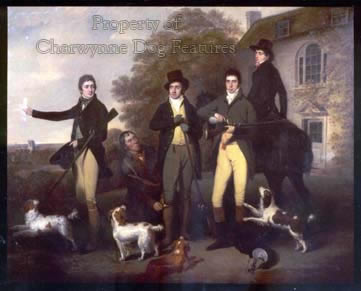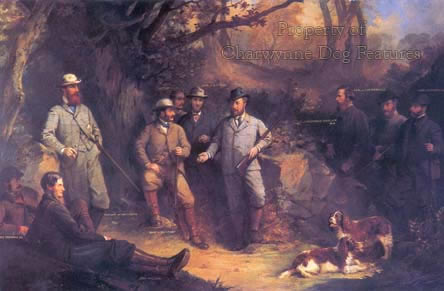129 SPANIELS SPRINGING FROM NORFOLK
SPANIELS SPRINGING FROM NORFOLK
by David Hancock
 If you wish to read about the authentic origins of your particular breed of gundog, then the official histories of our pedigree breeds of dog are not always the best place to look. And the breed of English springer spaniel is no exception. The authorised blueprint for the breed, the Kennel Club standard, refers to "a breed of ancient and pure origins, oldest of sporting gundogs" and "raciest in build of all British land spaniels." This wording flies in the face of a number of facts. Spaniels were not truly breeds until the end of the 19th century when field trials for spaniels demanded their registration as breeds rather than separation by size, weight or colour. Gervase Markham even in the 17th century was describing the true-bred land spaniel with the caveat..."if one could still find one of those". There is also an abundance of references to 'setting dogs' far earlier than references to spaniels.
If you wish to read about the authentic origins of your particular breed of gundog, then the official histories of our pedigree breeds of dog are not always the best place to look. And the breed of English springer spaniel is no exception. The authorised blueprint for the breed, the Kennel Club standard, refers to "a breed of ancient and pure origins, oldest of sporting gundogs" and "raciest in build of all British land spaniels." This wording flies in the face of a number of facts. Spaniels were not truly breeds until the end of the 19th century when field trials for spaniels demanded their registration as breeds rather than separation by size, weight or colour. Gervase Markham even in the 17th century was describing the true-bred land spaniel with the caveat..."if one could still find one of those". There is also an abundance of references to 'setting dogs' far earlier than references to spaniels.
Inadequate research into the association of the breed with the word 'Norfolk' has not helped; again and again, breed historians link this name with the Duke of Norfolk. The poet Southey's collection contains references to the Duke of Norfolk and his spaniels. These were not sporting spaniels however but toy spaniels , being described as "King James's", black and tan, and "solely" in his possession. In his valuable and authoritative "The Dog Book" of 1906, James Watson comments: "...even the usually trustworthy Dalziel is found surmising that this was the Duke of Norfolk's breed, hence the name. (Rawdon) Lee follows suit and quotes Youatt as to the Duke getting the black and tan by crossing with the terrier." But the link is with the county rather than the duke.
A number of writers have denied the existence of Norfolk spaniels but authors such as Vero Shaw, 'Idstone', 'Stonehenge' and Stables describe them fully under that name and virtually as English springers. Bede Maxwell, in her powerfully-argued and forthrightly-written "The Truth about Sporting Dogs", does get nearer to the truth when she writes: "My thought is that the name could be purely geographical". She then suggests a link between the Norfolk spaniel, liver and white and bigger than other spaniel breeds, and the Coke family of Holkham Hall in Norfolk in the very early part of the 19th century. She quotes 'Idstone's' reference to the fact that "Mr. Coke and the Duke (i.e. of Gordon) bred from the same stock" - Gordon setters in this case, as clear evidence of Coke's possession of high quality gundogs.
Leighton-Boyce and Gompertz, the justly well-respected breed historians of setter breeds, both acknowledge that Alexander, fourth Duke of Gordon (1743-1827) obtained his original setters from Thomas William Coke (1754-1842), later Earl of Leicester, around 1815. Coke also favoured pointers, as Reinagle's portrait of him in 1815 indicates. Coke would have needed dogs for spaniel work too. They too would have been bred to his standards and therefore coveted.
Thornhill describes Coke as..."a man of fortune, surrounded with gamekeepers...pointers, setters, etc, without number..." Coke is nationally famous as an agricultural innovator and an acknowledged breeder of farm animals, but also as a superlative shot and sporting landowner. But any link between this celebrated sportsman and a particular type of sporting spaniel is best illustrated in three separate portraits of him. For the two major portraits of Coke on display at his family home to feature spaniels indicates to me the value he placed on them. The third painting shows Coke as a youth, but also features a brown and white spaniel and again confirms his partiality for this type of dog.
There would have been no shortage of spaniel work in Norfolk when Thomas Coke and his neighbours were shooting. His estate comprised 40,000 acres, with the first game records starting in 1789. From Elveden Hall on Breckland Heath up on the Suffolk border across to the Sandringham estate, there was Lord Walsingham's Merton, Lord Henniker's Thornton, Lord Abemarle's Quidenham, the Duke of Grafton's Euston, as well as Holkham, with Lord Kensington's Heydon Hall, Lord Orford's Houghton and the Windhams' Felbrigg not far away. Walked up shooting on estates such as these would have demanded the support of spaniels by the hundred. The nearby fens and the needs of the wildfowlers would have substantially increased that demand. There is a delightful picture, by William Redmore Bigg in 1803, of a shooting party at Felbrigg Hall which depicts the Norfolk type of spaniel. There is another painting, 'A Big Shoot at Sandringham in 1867' by Thomas Jones Barker, which also portrays perfectly the liver and white spaniels in use in Norfolk in those times.
Before the days of driven game, pheasants were quite often shot by a man on his own in covert with a 'bobbery' pack of spaniels. Shooting in the fens was conducted using a pointer or a springer. In "The Banville Diaries - Journals of a Norfolk Gamekeeper, 1822-44" there is a charming colour print of snipe shooting in the early 19th century showing a springer and a pointer working together. Coke supplied gundogs -- setters, pointers and spaniels to his fellow sportsmen. He was a highly respected breeder of farm animals (successful with cattle breeds and the Suffolk breed of pig) and maintained his own pack of foxhounds.
At the turn of the century Coke was acknowledged as just about the best exponent of shooting flying. In 1797, within a circumference of a mile, he is reported to have shot forty brace in 93 shots in eight hours; each bird was apparently shot singly. Colonel Peter Hawker in Hampshire was his main rival as a shot. Coke had lived and studied abroad, was a leading Whig politician who revitalised his estate's finances. This was a man who had the individuality to twice reject a title (finally accepting an earldom in 1837) and the social standing which enabled him to turn down a royal request to shoot on his estate. As a successful breeder of foxhounds, a renowned breeder of farm animals and a respected breeder of setters, he would have had top class spaniels. If the Duke of Gordon wanted to own Coke's setters, wouldn't his spaniels have been prized too?
The Norfolk spaniel featured the liver colour (inherited from the water dog as the surviving water spaniels and some retriever breeds illustrate today) and a coat inclined to curl (associated too with the water spaniels and also inherited from the ancient water dogs, as the Barbet of France, the Wetterhoun of Holland, the Portuguese and Spanish dogs demonstrate to this day). Spaniels in a county such as Norfolk, with its fens, lengthy coastline and long wildfowling heritage, would need to be good in water. If Coke's spaniels were anywhere near as good as his other livestock, they would not have been confined to Norfolk for very long.
Vero Shaw described the Norfolk spaniel as like a thick-made English setter, liver and white - heavily flecked, with a blaze of white up the forehead. Dalziel describes the Norfolk as belonging to the springer family, liver and white and leggy. 'Stonehenge' says the breed should stand 17 to 18" and Youatt states that the Norfolk of his day was larger, stouter, and stauncher than the "common Springer".
Across the sea from Norfolk lies Holland with traditional trade routes between the two. Holland was once famous for its hawking and its hawking dogs, as well as its decoy dogs (the Kooikerhondje surviving to this day) and water dogs (the wetterhoun also remaining). The Wetterhoun is remarkably similar to our (now extinct) English Water Spaniel: curly-coated, liver and white, 21" at the withers.
In 19th century Norfolk, dark reddish-brown springer spaniels, retrievers and water spaniels were frequently interbred, good dog to good dog, performance rated above purity as usual in past times. At Aqualate, Shropshire, the Boughey family kept a stud book from 1813 onwards for their 'springer' spaniels, introducing the blood of a French poodle at one stage for "extra sagacity". The Boughey's Mop 1 and Velox Powder are an important part of the pedigree English springer's heritage.
Today the English Springer Spaniel is our most successful sporting spaniel. The topknots and curly coats have been mainly bred out, although they still crop up from time to time. But the Norfolk influence has lasting significance. Men like Coke of Norfolk and Boughey of Aqualate bred for excellence in the field not handsomeness of appearance. They have left us an outstanding breed to provide both an efficient service in the shooting field and great companionship at the hearth. The prowess of working springers in Norfolk in past centuries should never be devalued by being blurred with the Toy Dogs of a Duke, wherever his dukedom is located.